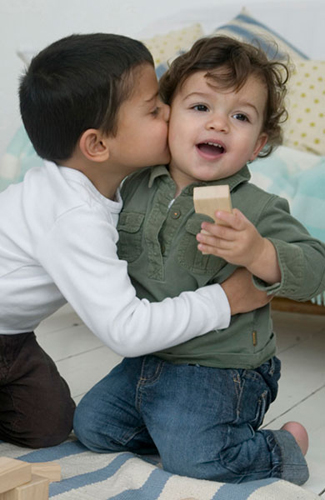Fighting between siblings A constant battle or beneficial?
Eighty percent of us
have brothers and sisters. Within this common and familiar relationship
runs the whole gamut of human emotions, from murderous hatred to
fawning adoration and, in between, considerable ambivalence. All of
these emotional responses cause parents a great deal of worry and
present them with distressing management challenges. In fact, research
looking at children’s reactions to seeing their baby brother or sister
upset shows that it is normal for children to show a range of emotions
from being upset themselves, to not being affected at all, to being
delighted at the baby’s distress, with some even trying to make them
more upset! The bottom line is that rivalry and conflict between
brothers and sisters is normal and inevitable.
Practice for later life
Sibling rivalry is a
perfect opportunity for children to practice conflict resolution. Given
that they live together, some resolution has to be found: They cannot
walk away from this situation. In an argument, each child needs to be
able to state his case and stand his ground. He needs to learn to say
how he feels and what he wants. Finally, he must negotiate terms of
ceasefire or surrender, and an end to the conflict. Your son or daughter
is learning an important lesson about how to understand, manipulate and
dominate, comfort and appease another person. It is better, therefore,
for parents to intervene as little as possible, and allow these skills
to be developed and honed in this relatively safe environment.
Factors affecting conflict
The closer in age
siblings are, the more likely there is to be keen competition between
them and an increased risk of conflict. Same-sex siblings tend to fight
more. The younger the siblings are, the more likely it is that they will
come to blows. Sometimes the rage and frustration can be overwhelming,
especially for a toddler who does not have the verbal ability to hold
his own against an older sibling. But it can be equally galling for an
older sibling who is expected to treat his destructive younger sibling
with special tolerance.
All getting along?
To prevent
situations from reaching boiling point, there are important measures
that parents can take to promote sibling harmony. It is important to be
fair; not to make your children compete for your time and attention; not
to favor one over the other; to model harmonious, respectful
relationships with your partner, your own family and brothers and
sisters; not to “guilt trip” one, often the oldest, about fighting with
his sibling; and, very importantly, to make a big show of your approval
when they are cooperating and playing nicely together. Parents will need
to set rules about hitting and hurting each other and about breaking
property. They also need to enforce these rules. They can make it clear
that they understand each child’s position and sympathize with their
dilemmas, but that they do not approve of aggressive or destructive
behavior.
Last resorts
When it gets
extreme, and warnings have been given but the rules have still been
broken, parents will need to intervene. At this point, you still have an
opportunity to encourage some non-violent resolution, such as taking
turns. If all else fails, the best course of action is to keep calm,
remove the source of conflict, and apply normal consequences for
unacceptable behavior. These consequences could include being sent to
sit on a “time-out step” or having the toy or object they are fighting
over removed for ten minutes or so. Make sure that any consequences are
immediate and brief, since at this age children have little
self-control. Next time, the warring parties may be more likely to find
their own resolution.
Fighting and making up
Younger children are more
likely to fight, especially if they are the same sex or similar in age.
However, battles, although frequent, will probably be short-lived at
this age.


Conflict resolution
Although it is best
to allow your children to find solutions to their own squabbles, you may
have to step in occasionally to model good behavior or apply
consequences.
